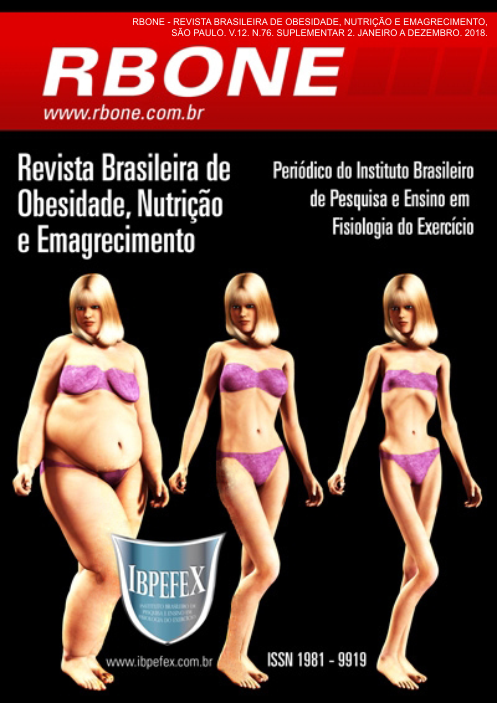Evaluation of the nutritional state of employee of feeding units of the São Francisco Valley
Abstract
Food and Nutrition Unit (UAN) aims to provide balanced meals and promote healthy food to its clientele. There has been an increasing increase of overweight and obesity in the population in the last decades. The objective of this study was to evaluate the nutritional status of employees of the Food and Nutrition Unit of two university restaurants in Juazeiro-BA and the other in Petrolina-PE. A total of 24 people were evaluated, including weight, height, waist and hip circumference, and percentage of body fat, as well as data such as ethnicity, sex, age and occupation. Body mass index (BMI), hip ratio and waist / height ratio were used to evaluate the nutritional status of the individual. The highest prevalence was observed among overweight individuals with BMI greater than 24.9 kg / m², having high waist circumference and excess body fat. The present study found a higher prevalence of overweight, with risks of developing cardiovascular diseases in workers, indicating that the objectives of the PAT need to be taken into account, making nutritional assistance necessary in this group.
References
-ABESO, Associação Brasileira para o Estudo da Obesidade e da Síndrome Metabólica. Diretrizes brasileiras de obesidade. São Paulo, 4.ed. 2016.
-Abreu, E.S.; Spinellu, M.G.N.; Zanarde, A.M. P. Gestão de Unidades de Alimentação e Nutrição: um modo de fazer. São Paulo. Editora Metha. 2016. p. 127-141.
-Barbosa, L. N.; Almeida, F. Q. A. Relato de experiência sobre a avaliação dos riscos ambientais e mapeamento em uma unidade de alimentação e nutrição (UAN) para a promoção da segurança no trabalho. Revista Simbiologias. Botucatu. Vol. 1. Num. 2. 2008.
-Bezerra, I. W. L.; Oliveira, A. G.; Pinheiro, L. G. B.; Evaluation of the nutritional status of workers of transformation industries adherent to the Brazilian Workers' Food Program. A comparative study. PLOS ONE. França. Vol. 12. Num 2. 2017.
-Boclin, K. L. S.; Blank, N. Excesso de peso: característica dos trabalhadores de cozinhas coletivas? Revista brasileira de saúde ocupacional. São Paulo. Vol. 31. Num 113. 2006.p. 41-47.
-Cuppari, L. Nutrição clínica no adulto –Guia de medicina ambulatorial e hospitalar (UNIFESP/Escola Paulista de Medicina). São Paulo: Manole, 2002.
-Guimarães, M.; Estevam, E. Caracterização do perfil nutricional e dos aspectos ergonômicos relacionados ao trabalho de colaboradores de uma unidade de alimentação e nutrição. Belo Horizonte. Revista Científica da Faminas. Vol. 9. Num. 2. 2013. p. 56-68.
-International Association for the Study of Obesity. 2011. Disponível em: <http://www.ioft.org/>. Acesso em: 12/07/2017.
-Lacaz, F. A. C.; Lourenço, E. A. S. Política Nacional de Saúde do Trabalhador: desafios e dificuldades. Os desafios para a implantação da política de Saúde do Trabalhador no SUS: o caso da região de Franca-SP. São Paulo. Revista Brasileira de Saúde Ocupacional. Vol. 39. Num. 127. 2010. p. 199-230.
-Lanci, K. N. S.; Matsumoto, K. L. Avaliação nutricional e análise do cardápio oferecido para funcionários beneficiados pelo Programa de Alimentação do Trabalhador em uma indústria de Paranavaí, Paraná. SaBios: Rev. Saúde e Biol. Vol. 8. Num.3. 2013. p. 3-12.
-Matos, C. H; Proença, R. P. C. Condições de trabalho e estado nutricional de operadores do setor de alimentação coletiva: um estudo de caso. Campinas. Revista Nutrição. Vol. 16. Num. 4. 2003. p. 493-502.
-Mccarthy, H. D.; Ashwell, M. A study of central fatness using waist-to-heightratios in UK children and adolescents over two decades supports the simple message’ keep your waist circumference to less than half your height’. London. Int J Obes. Vol. 30. p. 988-892. 2006.
-PAT, Programa de Alimentação do Trabalhador. Programa de Alimentação do Trabalhador: legislação. 10ªedição. Brasília. MTE, SIT, DSST, COPAT, 2007.
-Paiva, A. C.; Cruz, A. A. F. Estado nutricional e aspectos ergonômicos de trabalhadores de unidade de alimentação e nutrição. Minas Gerais. Revista Mineira de Ciências da Saúde. Vol. 1. Num. 1. 2009. p. 1-11.
-Paixão, M. C. P.; Paixão, S. J. P.; Franco, L. R. Obesidade como fator de risco para acidentes no trabalho. Paraná. Rev Saúde Pesquisa. Vol. 2. Num. 2. 2009. p. 379-386.
-Rodrigues, P. C. Estudo sobre obesidade mórbida, produzido na UNB, mostra dados inéditos. 37ªedição. Revista da Abeso. Disponível em:<http://www.abeso.org.br/pagina/242/estudo-sobre-obesidade-morbida,-produzido-na-unb,-mostra-dados-ineditos.shtml>. Acesso em:15/07/2017.
-Silva, K.F.; Drumond, N. B.; Quintão, D. F. Avaliação do perfil nutricional e condições de trabalho de colaboradores de unidades de alimentação e nutrição de Eugenópolis (MG). Belo Horizonte. Revista Cientifica de Faminas. Vol. 11. Num. 2. 2015. p. 34-48.
-Simon, M. I. S. S.; Garcia, C. A.; Lino, N. D.; Forte, G. C.; Fontoura, I. D.; Oliveira, A. B. A. Avaliação nutricional dos profissionais do serviço de nutrição e dietética de um hospital terciário de Porto Alegre. Rio de Janeiro. Cad. Saúde Colet. Vol. 22. Num. 1.2014. p. 69-74.
-World Health Organization. Obesity: preventingandmanaging the global epidemic. Reportof a World Health Organization Consultation. Geneva: World Health Organization, 2000. p. 256. WHO Obesity Technical Report Series. Num. 284.
Authors who publish in this journal agree to the following terms:
- Authors retain the copyright and grant the journal the right of first publication, with work simultaneously licensed under the Creative Commons Attribution License BY-NC which allows the sharing of the work with acknowledgment of the authorship of the work and initial publication in this journal.
- Authors are authorized to enter into additional contracts separately for non-exclusive distribution of the version of the work published in this journal (eg, publishing in institutional repository or book chapter), with acknowledgment of authorship and initial publication in this journal.
- Authors are allowed and encouraged to post and distribute their work online (eg, in institutional repositories or on their personal page) at any point before or during the editorial process, as this can bring about productive change as well as increase impact and impact. citation of published work (See The Effect of Free Access).






